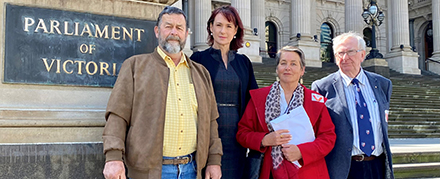Hundreds of Victorians have signed petitions urging the retention of the state’s native forest industry and an upgraded policy of fuel reduction burning. Source: Philip Hopkins for Timberbiz
Ecologist and niche timber harvester James Kidman, who operates in the Otway Ranges just past Geelong in south-west Victoria, received 893 signatures to his petition launched earlier this year.
“The petition went well,” he said, the numbers exceeding those who responded to the review of the Victorian Regional Forest Agreements. Mr Kidman said the RFA Review had 733 online survey responses and 135 written responses – a total of 868 responses.
Similarly, the Howitt Society’s e-petition calling for an increase in fuel reduction burning was signed by 738 people and tabled in Parliament last week. It was sponsored by the Shadow Minister for Public Land Use. Melina Bath, who is the Nationals Member for Eastern Victoria Region.
Mr Kidman wrote a comprehensive submission on forestry as the basis of his petition. The petition’s aim was to amend the Victorian Forest Plan, which will shut the industry by 2030, to instead provide for ecologically sustainable production of hardwood timber in state forest, with a focus on high-value products.
Mr Kidman, in his 30s, harvests native forest hardwood for guitars made by Australian instrument makers and played by Australian and international artists. He has an honours degree in botany, ecology and conservation from Melbourne University; and has worked as a land manager with traditional Pitjantjatjara owners in Central Australia. He adamantly opposes to the Andrews Government’s Forestry Plan.
Ms Bath said the Howitt Society’s e-petition called on the Andrews Government to increase the area of planned low-intensity burns to the five per cent level of forest recommended by the 2009 Bushfire Royal Commission.
The society, named after famed 19th Century scientist, botanist and explorer Alfred Howitt, consists of experienced land and fire managers, scientists, foresters, anthropologists and historians who have a wealth of knowledge about the bush and public land management.
“Victorian forests need to be actively managed using regular low-intensity mosaic burns that incorporate, where possible, methods practiced by Traditional Owners in the past,” she said.






